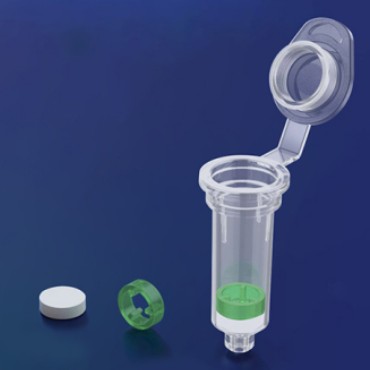Introduction to Nucleic Acid Purification Using Spin Columns
The nucleic acid extraction instrument is an instrument that automatically completes the nucleic acid extraction of samples by applying the supporting nucleic acid extraction reagents. Widely used in disease control centers, clinical disease diagnosis, blood transfusion safety, forensic identification, environmental microbial testing, food safety testing, animal husbandry and molecular biology research and other fields.
Nucleic acid extractors are divided according to different extraction principles
1) Instruments using the spin column method
Spin-column nucleic acid extractor mainly uses a combination of the centrifuge and automatic pipetting device. The throughput is generally 1-12 samples. The operation time is similar to that of manual extraction, which cannot improve the actual work efficiency, and the price is expensive. Different models The consumables of the instrument are also not universal and are only suitable for large laboratories with sufficient funds.
2) Instruments using the magnetic bead method
Using magnetic beads as the carrier, using the principle that magnetic beads adsorb nucleic acid under high salt and low pH value, and separate from nucleic acid under low salt and high pH value, and then move the magnetic beads or transfer the liquid to realize the entire extraction and purification process of nucleic acid. Due to the uniqueness of its principle, it can be designed into a variety of throughputs, which can be extracted from a single tube or 8-96 samples, and its operation is simple and fast. It only takes 30-45 minutes to extract 96 samples, which greatly improves the experimental efficiency is low and the cost is low so that it can be used in different laboratories, and it is the mainstream instrument on the market.
What is a nucleic acid purification column?
Nucleic acid purification columns can be used for DNA/RNA extraction and purification of various materials.
The nucleic acid purification column has the characteristics of simple operation, high recovery rate and stable performance. At present, the product has been used by most laboratories and companies at home and abroad. The nucleic acid purification column uses silica gel membrane as the specific adsorption material for nucleic acid and basically does not adsorb other biological materials, which can ensure the maximum recovery of DNA\RNA in the sample and remove other impurities at the same time.

Introduction to Nucleic Acid Purification Using Spin Columns
Nucleic acid purification with spin columns is a solid-phase extraction method for rapid nucleic acid purification. This method relies on the fact that nucleic acids bind to the solid phase of silica under certain conditions.
The stages of the method are lysis, binding, washing and elution. More specifically, this requires lysis of target cells to release nucleic acids, selective binding of nucleic acids to silica membranes, washing away of particles and inhibitors that are not bound to the silica membranes, and elution of nucleic acids, the end result of which is Nucleic acid purified in aqueous solution.
For lysis, the cells of the sample (blood, tissue, etc.) must be processed to disrupt cell membranes and release nucleic acids. Depending on the target material, this may include the use of detergents or other buffers, proteases or other enzymes, heating to different times/temperatures, or mechanical disruption such as cutting with a knife or homogenizer, using a mortar and pestle, or bead- Beat with a bead mill.
For binding, a buffer solution is then added to the lysed sample along with ethanol or isopropanol. The sample in the binding solution is then transferred to a spin column, which is then placed in a centrifuge or connected to a vacuum. The centrifuge/vacuum forces the solution through the silica membrane inside the spin column, and under the appropriate ionic conditions, the nucleic acids will bind to the silica membrane and the rest of the solution passes through. Combined with the target material, the flow through can be removed.
For washing, a new buffer is added to the column and centrifuged/evacuated through the membrane. This buffer is designed to maintain binding conditions while removing binding salts and other residual contaminants. Multiple washes are usually required, usually with increasing percentages of ethanol/isopropanol, until the nucleic acids on the silica membrane are free of contaminants. The final "wash" is usually a drying step that allows the alcohol to evaporate, leaving only the purified nucleic acid bound to the column.
Finally, elution is the process of adding an aqueous solution to the column, allowing hydrophilic nucleic acids to leave the column and return to the solution. This step can be improved by salt, pH, time or heat. Finally, to capture the eluate/eluate, transfer the column to a clean microtube before the final centrifugation step.
Professional manufacturer of Nucleic Acid (DNA & RNA) Extraction and Analysis products supplier
GENETURE is a group company,we own two factories: Ascend and Dianrun,to provide one stop solution of Nucleic Acid Extraction and Analysis,including solution for COVID-19. Geneture provides high quality and professional Nucleic Acid Extraction Reagents, Lab consumables, Real-time PCR consumables and test machines.
GENETURE main products including: Nucleic acid extraction or purification kit,Automatic nucleic acid extractor, PCR system, PCR kit, Magnetic beads, and lab consumables of 96 well deep plate,Magnetic rod comb,PCR tube,PCR plate,Pipette tips,centrifuge tubes.
If you have any questions about Nucleic Acid (DNA & RNA) Extraction or Spin Column , feel free to contact us.
Email: info@geneture.com
Mobile: +86 150 1002 8687
